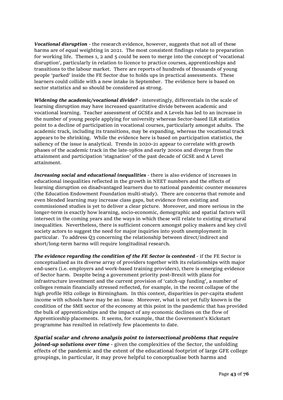
Page 43 of 76
Vocational disruption - the research evidence, however, suggests that not all of these
harms are of equal weighting in 2021. The most consistent findings relate to preparation
for working life. Themes 1, 2 and 5 could be seen to merge into the concept of 'vocational
disruption', particularly in relation to licence to practice courses, apprenticeships and
transitions to the labour market. There are reports of hundreds of thousands of young
people 'parked' inside the FE Sector due to holds ups in practical assessments. These
learners could collide with a new intake in September. The evidence here is based on
sector statistics and so should be considered as strong.
Widening the academic/vocational divide? - interestingly, differentials in the scale of
learning disruption may have increased quantitative divide between academic and
vocational learning. Teacher assessment of GCSEs and A Levels has led to an increase in
the number of young people applying for university whereas Sector-based ILR statistics
point to a decline of participation in vocational courses, particularly amongst adults. The
academic track, including its transitions, may be expanding, whereas the vocational track
appears to be shrinking. While the evidence here is based on participation statistics, the
saliency of the issue is analytical. Trends in 2020-21 appear to correlate with growth
phases of the academic track in the late-1980s and early 2000s and diverge from the
attainment and participation 'stagnation' of the past decade of GCSE and A Level
attainment.
Increasing social and educational inequalities - there is also evidence of increases in
educational inequalities reflected in the growth in NEET numbers and the effects of
learning disruption on disadvantaged learners due to national pandemic counter measures
(the Education Endowment Foundation multi-study). There are concerns that remote and
even blended learning may increase class gaps, but evidence from existing and
commissioned studies is yet to deliver a clear picture. Moreover, and more serious in the
longer-term is exactly how learning, socio-economic, demographic and spatial factors will
intersect in the coming years and the ways in which these will relate to existing structural
inequalities. Nevertheless, there is sufficient concern amongst policy makers and key civil
society actors to suggest the need for major inquiries into youth unemployment in
particular. To address Q3 concerning the relationship between direct/indirect and
short/long-term harms will require longitudinal research.
The evidence regarding the condition of the FE Sector is contested - if the FE Sector is
conceptualised as its diverse array of providers together with its relationships with major
end-users (i.e. employers and work-based training providers), there is emerging evidence
of Sector harm. Despite being a government priority post-Brexit with plans for
infrastructure investment and the current provision of 'catch-up funding', a number of
colleges remain financially stressed reflected, for example, in the recent collapse of the
high profile HS2 college in Birmingham. In this context, disparities in per-capita student
income with schools have may be an issue. Moreover, what is not yet fully known is the
condition of the SME sector of the economy at this point in the pandemic that has provided
the bulk of apprenticeships and the impact of any economic declines on the flow of
Apprenticeship placements. It seems, for example, that the Government's Kickstart
programme has resulted in relatively few placements to date.
Spatial scalar and chrono analysis point to intersectional problems that require
joined-up solutions over time - given the complexities of the Sector, the unfolding
effects of the pandemic and the extent of the educational footprint of large GFE college
groupings, in particular, it may prove helpful to conceptualise both harms and